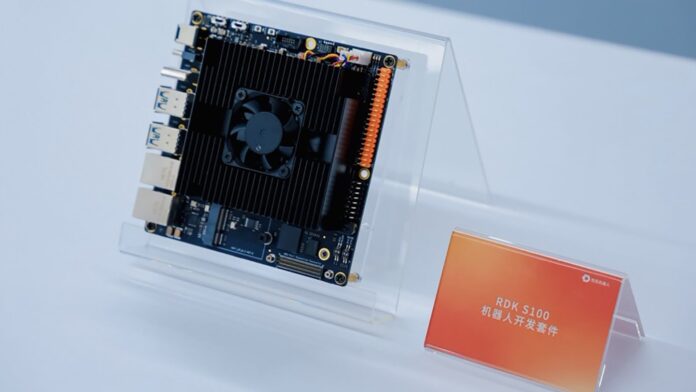RDK S100 offers a wide range of peripheral interfaces, and full-stack integration across hardware-software and edge-to cloud workflows. It is designed to help developers build embodied robotics more efficiently and deploy them in diverse real-world environments.
At the moment, embodied intelligent is evolving in two main directions: end-toend architectures and hierarchy decision models. The latter is considered easier to understand and implement. Their adoption is dependent on the availability flexible, power-efficient SoC platform that can handle diverse computational tasks. The RDK is designed to meet this requirement.
The RDK S100 integrates a CPU, a BPU, and a Microcontroller Unit (MCU) onto a single chip to reduce hardware costs, while enhancing system performance. This design allows the system to allocate high level processing to decision making functions while maintaining responsive motor controls, supporting coordinated real-time operations between the robot’s systems.
Hybrid architecture allows for dynamic switching and fusion of large and small AI model. This setup is capable of handling a wide range complex tasks. Large models, like vision-language models (VLMs), or large language models are used to perform perception and decision making, while smaller models control motor functions with speed and precision. According to reports, the integration of MCU and BPU can reduce CPU workload up to 80%. This improves system responsiveness.
Consider, for example, a scenario in which a robot has to retrieve a cup. After receiving a voice order, the CPU and BPU activate visual-semantic functions. They analyze visual input and contextual information while accounting for the current state of the robot. The BPU then generates a plan of motion, which the MCU executes in real-time, allowing the robot to perform the task with precision.
This kit includes a number of peripheral interfaces that support research, prototyping, and testing. D-Robotics provides a development platform that includes AI modeling software, hardware acceleration packages and model optimization kits. It also offers a library with more than 200 open-source algorithm and application demonstrations.
Hu Chunxu (VP of D-Robotics overseeing the developer eco-system) categorized the robotics industry into three broad segments in a media interview:
- Traditional Robotssuch as industrial systems, robotic vacuum cleaners and other robots that operate in a mature market with a high level of competition.
- Emerging robotic formats for niche applicationsinclude pool cleaners and lawn mowers. These robots are designed to solve specific problems by using intelligent features.
- Embodied roboticsystems, such as large quadruped and humanoid systems, must perform complex perception tasks and make decisions, requiring a significant amount of computing power.
Recognizing the different computational requirements across these categories, Hu stated that D-Robotics will release additional boards with varying performance specifications alongside the RDK s100 to support a broader range of use cases.
According to the company, it has formed partnerships with more than 20 companies working on embodied intelligence and is conducting trials of the RDK S100 with over 50 clients. The kit is priced at RMB 2,799 (USD 391.9) and is compatible with a range of robotic systems, including those requiring bird’s eye view (BEV) or multi-stream video detection.
Looking ahead, D-Robotics plans to introduce more high-performance offerings in the first quarter of 2026 to further support the development of advanced embodied robotics.
KrASIA Connection features translated and adapted content that was originally published by 36Kr. This article was written by Huang Nan for 36Kr.





